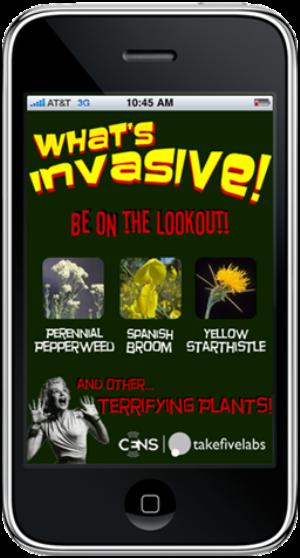|

NPS
Contact: Lauren Newman, 805-370-2343 Citizen scientists have a new research tool to bring along on trips to the Santa Monica Mountains. The National Park Service (NPS) and the UCLA Center for Embedded Network Sensing (CENS) have partnered to design a smartphone application for a unique purpose: to identify the locations of invasive weeds in the Santa Monica Mountains National Recreation Area. The What’s Invasive! application, which can be downloaded onto any iPhone or Android mobile phone, allows visitors to the Santa Monica Mountains National Recreation Area (and soon other NPS locations) to snap a picture and map the location of an invasive weed found while out on a hike, bike ride, or horseback ride. This project will help National Park Service staff identify where weeds need to be removed in the park.
The location of each weed that a citizen scientist documents in the park is automatically uploaded to the What’s Invasive! website, allowing park staff and the public to see maps of invasive weed clusters and how they are spreading in the mountains. The website also tracks which citizen scientists are doing the most research, and guides people who are interested in the project, but may not have very much experience with technology, through the application set-up and options to use email and text message as alternatives.
Invasive weeds are a significant threat to native plant and animal species in the Santa Monica Mountains. Native food sources that wild animals rely on are being crowded out by proliferating non-native plants. Some invasive weeds are actually harmful if animals consume them, like Yellow Starthistle, which causes brain lesions and mouth ulcers in horses. Others, like the Giant Reed, invade along creek banks and decrease a creek’s ability to act as a fire barrier in the mountains. Many invasive weeds consume far more water than native plants, and some, like Poison Hemlock and Perennial Pepperweed, displace native plants that are effective at holding soil in place, and instead create erosion and increase the possibility of mud slides.
Combating invasive weeds requires a significant investment of resources. The Santa Monica Mountains National Recreation Area spent $200,000 over a three year period to map invasive weeds in the mountains. Assistance from citizen scientists in order to keep this map up to date and better equip park staff and volunteers to remove invasive weeds will help expand the scope of the effort.
The technology behind the What’s Invasive! project was developed by the UCLA Center for Embedded Network Sensing (cens.ucla.edu), a National Science Foundation supported research center that develops ways to link human interaction with the natural world and technology. The data gathered for the What’s Invasive! project serves a dual purpose in that it also provides a map of where visitors go in the mountains, based on the places that invasive weed photographs and locations are documented. Beyond the What’s Invasive! project, this information has the potential to inform research about a broad array of policies ranging from recreation planning to sustainable transit programs.
The What’s Invasive! application is one of several being developed by the Center for Embedded Network Sensing. In the spring, the National Park Service will once again partner with CENS to create a What’s Blooming application that will allow park visitors to track wildflower blooms in the mountains. Other applications are available and utilized by a number of public agencies and educators, including one that allows mobile phone users to explore and share how they impact the environment and how extensively they are exposed to pollutants. The Center welcomes ideas and suggestions about new applications, and invites education partners to collaborate in developing applications that support classroom study.
To learn more about the project and the What’s Invasive! smartphone application, please visit: http://whatsinvasive.com/. To plan a trip to the Santa Monica Mountains Recreation Area, please visit www.nps.gov/samo. |
Last updated: March 1, 2015
